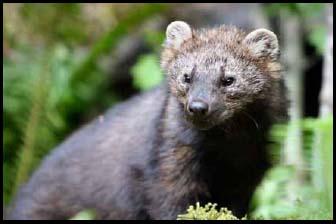They might not be the economic draw that wolves are to Yellowstone National Park, but fishers seem to be taking to Olympic National Park just about as favorably as the larger predators did to Yellowstone in their recovery program. This week a third batch of the cat-sized predators will be set free in Olympic to build on two successful years of a recovery program designed to repopulate the park with fishers.
Fishers are members of the weasel family, related to minks, otters and martens. They are native to the forests of Washington, including the Olympic Peninsula, but vanished from the state decades ago because of over-trapping in the late 1800s and early 1900s and habitat loss and fragmentation.
Fishers were listed as a state endangered species in 1998 by the Washington Fish and Wildlife Commission and were designated as a candidate for federal listing in 2004 by the U.S. Fish and Wildlife Service under the Endangered Species Act. Those listings led to the current recovery program, which was launched on the ground in the park in January and March of 2008 when 18 of the animals, each fitted with a tiny radio transmitter, were the first to be released in the park. Last December another 15 or so were set free.
This coming week another batch of fishers will be freed in the park, with more to be released later this winter.
“We are extremely grateful to the many partners who are making this project possible,” said Olympic National Park Superintendent Karen Gustin. “In particular, nonprofit partners Conservation Northwest, the Doris Duke Foundation and the Wildlife Conservation Society are providing crucial support for this final year of fisher releases.”
As in previous years, each released animal will wear a small radio transmitter, allowing biologists to track and monitor its movements. Biologists continue to monitor 22 fishers that were released during the past two winters. Also, with the discovery of three fisher birthing dens last summer, biologists determined that three females gave birth to at least seven kits. Other females may also have had young, but locating and verifying fisher dens is extremely difficult and time-consuming in the Olympic wilderness, according to park officials.
Fisher reintroduction to Olympic National Park is made possible through a partnership of agencies and organizations. The Washington Department of Fish and Wildlife and Olympic National Park are joint project managers and, along with the U.S. Geological Survey, are leading a research and monitoring program to evaluate the success of the reintroduction. The British Columbia Ministry of Environment is actively supporting the effort to capture and import fishers to Washington.
The goal of the three-year project is to release approximately 100 fishers to the Olympic Peninsula to re-establish a self-sustaining population. During the first two winters, 49 fishers were released. Since then, biologists have maintained frequent monitoring of the fishers' radio collar signals. Despite extensive searching, the whereabouts of six fishers is unknown. Two animals’ radio signals have failed, 15 animals are known to have died and four are presumed to be dead. Partners in the project expect to release 40 to 45 more animals within the park this winter, which is the third and final year of releases.
“With this new group of fishers, we’re getting closer to reaching our target of releasing 100 on the Peninsula,” said Dave Brittell, assistant director of the WDFW wildlife program. “It’s great to watch these animals blend back into the forests of the Olympic Peninsula and we appreciate collaborating with a great group of people from a number of organizations to accomplish this work.”
Non-profit partner Conservation Northwest provides financial and administrative support for the project’s operations in British Columbia and coordinates volunteers who track fisher activity through remote camera stations. Washington’s National Park Fund provides financial support for monitoring the reintroduced fisher population. Other partners and organizations are providing financial or logistical support for management and research tasks.
“With this release, the park’s new fisher population grows increasingly secure,” said Dave Werntz, conservation director at Conservation Northwest. “It shows the amazing things we can accomplish when we work in common cause with state and federal partners.”




Add comment